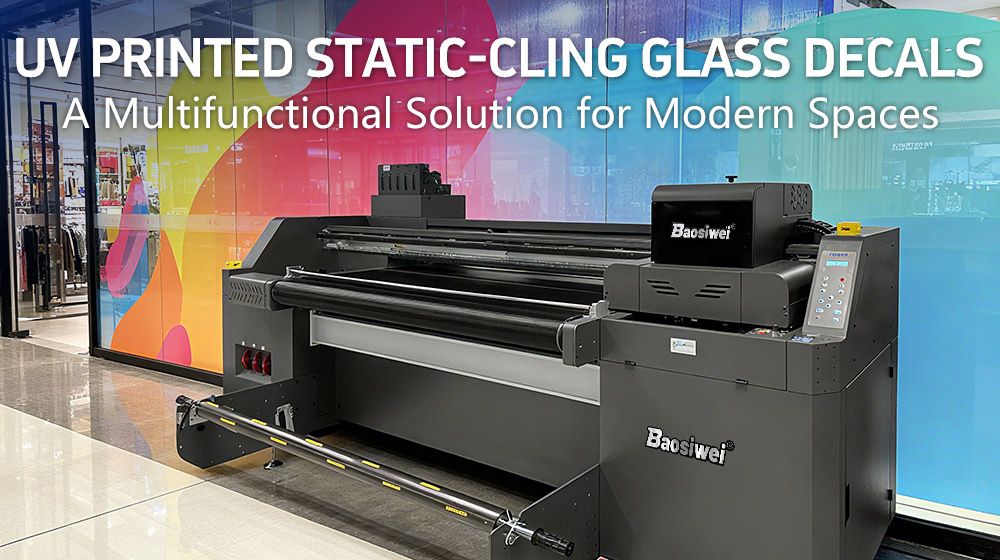
UV Printed Static-Cling Glass Decals — A Multifunctional Solution for Modern Spaces
In contemporary interior and commercial design, glass is no longer just a structural element — it has become a canvas for creativity, brand expression, and privacy. UV printed static-cling glass decals offer an innovative solution, combining flexibility, aesthetics, and functionality, suitable for homes, offices, and retail spaces.
This article introduces the features, applications, common issues, and installation steps of static-cling glass decals, with a focus on three main UV printing processes, helping you fully understand diverse glass decal solutions.
What Are UV Printed Static-Cling Glass Decals?
UV printed glass decals are made from high-quality PVC static-cling film, which adheres to glass surfaces using static electricity — no glue is required, and removal is easy. Unlike traditional adhesive stickers, static-cling decals attach directly to smooth glass surfaces without leaving residue. They are easy to install, reusable, and ideal for temporary displays, seasonal designs, or situations where flexible replacement is needed.
Key Product Features
- Glue-free design, no residue: Installs via static adhesion, requires no tools, and leaves no traces.
- Reusable: Easily removed, repositioned, and stored for future use.
- Eco-friendly and safe: Made from premium PVC material, releasing no harmful gases and unaffected by temperature-induced shrinkage.
- Rich decorative effects: Can achieve 3D textures, frosted privacy, or light-diffusing effects, supporting fully customizable designs.
- Functional versatility: Offers heat insulation, privacy protection, and one-way visibility.
- Wide application: Suitable for glass partitions, lobbies, shower enclosures, sliding doors, residential and commercial windows, sunrooms, and even car windows.
Application Scenarios for UV Static-Cling Glass Decals
- Office space beautification and privacy design Instantly add company logos, creative patterns, or privacy strips to glass partitions without structural changes, enhancing aesthetics and privacy in shared spaces.
- Retail window promotion and display Quick-change promotional tool: easily apply and remove sales information, business hours, or seasonal/holiday graphics.
- Home decoration Improve privacy and aesthetics without expensive renovations — frosted or patterned glass decals work well in kitchens, bathrooms, and living rooms.
- Elevator creative advertising Serve as eye-catching elevator ads for products or seasonal promotions, with graphics easily updated at any time.
Common Issues and How to Avoid Them
As ultra-clear UV printed decals become popular, some users report:
- Edges curling
- Foggy or bubbly graphics
- Poor adhesion or easy detachment
These problems often result from improper installation or low-quality film. Selecting high-quality products and following the correct UV static-cling decal installation steps can effectively prevent these issues.
UV Static-Cling Glass Decal Installation Steps (with visual guide)
Step 1: Clean the glass surface
Wipe with a lint-free damp cloth to remove dust and oil.
Step 2: Prepare soapy water
Add 2–4 drops of dish soap to approximately 350 ml of clean water.
Step 3: Spray the glass surface
Evenly spray the target glass area with soapy water to allow easy positioning.
Step 4: Remove protective backing
Gently peel off the protective film from the decal.
Step 5: Spray the adhesive side
Spray soapy water on the adhesion surface of the decal.
Step 6: Apply and position
Place the decal on the glass; the soapy water allows smooth adjustments.
Step 7: Remove bubbles and water
Use a squeegee or credit card to push out air bubbles and excess water from the center outward.
Step 8: Dry and let set
Wipe remaining water with a clean cloth and let it air dry. The static cling will securely hold the decal in place.
Tips:
- Avoid installation under direct sunlight or high temperatures.
- Keep the backing paper for easy storage and reuse.
UV Glass Decal Printing Processes
To meet diverse advertising and decorative needs, Baosiwei UV printers support multiple printing processes. Beyond simple single-color and color-white printing, here are the three most popular processes:
Process 1: Color-White-Color (CWC)
- Structure: Color – White – Color (three layers)
- Features: Most common decal type, with white layer as a base for vibrant visuals.
Advantages:
- Double-sided display: color visible from both sides (back side usually mirrored).
- Cost-effective: simple process, fast printing, suitable for large production runs.
- Widely applicable: mall windows, restaurant glass doors, event advertising.
Ideal for clients seeking quick, vibrant, and economical results.
Process 2: Color-White-Black-White-Color (CWBWC)
- Structure: Color – White – Black – White – Color (five layers)
- Features: Adds black isolation layer and double white layers for double-sided true images without ghosting.
Advantages:
- True double-sided visuals: independent and clear graphics on both sides.
- Compatible with multiple materials: ultra-clear glass, transparent PVC sheets, etc.
- Superior image quality: double white layers enhance color saturation and detail.
Ideal for high-end mall window advertising, double-sided displays, and premium brand promotion.
Process 3: Color-White-Color + Varnish (Frosted Varnish Effect)
- Structure: Color – White – Color with frosted varnish layer
- Features: Varnish layer creates a special textured effect.
Advantages:
- High-end texture: achieves frosted glass effect.
- Aesthetic + privacy: frosted varnish allows light transmission without compromising privacy.
- Durable protection: varnish layer improves scratch resistance and extends lifespan.
Widely used for home decoration, office design, and high-end retail spaces — more than an ad solution, it enhances spatial aesthetics.
More UV Glass Decal Process Combinations
Beyond the three main processes (CWC, CWBWC, CWC + Varnish), UV printing offers even more creative possibilities. By combining multi-layer printing with selective effects, one printer can deliver over ten mature processes, covering 99% of market decal needs:
- CWC + Foil: Adds metallic foil to double-sided color printing, creating a premium metallic effect for luxury window displays.
- CWC + Spot Varnish: Applies varnish in selected areas to produce highlights or embossed effects, enhancing visual depth and tactile feel.
- CWC + Foil + Frosted Varnish: Combines metallic and frosted effects, creating striking contrasts of glossy and matte textures.
- CWC + Foil + Frosted Varnish + Cutouts: High-end composite process combining foil, frosted texture, and cutouts for custom, creative designs in premium commercial spaces.
With these combinations, UV printers can satisfy nearly all creative demands of advertisers, designers, and brands, from single to composite processes, saving investment costs while enabling fast responses to client needs.
Machine Selection
Achieving these multi-layered, textured printing effects requires high-precision industrial UV printers. For glass decal printing, Baosiwei proudly offers the JW-1904 UV Hybrid Printer:
- Precise multi-layer printing control for all glass decal processes
- Strong productivity and stability to ensure consistent quality
- Professional color management system for sharp, saturated graphics
- Complete, mature printing solutions for the glass decal industry
Whether for commercial advertising, home decoration, or high-end retail spaces, Baosiwei provides reliable printing equipment and solutions.
Conclusion
UV printed static-cling glass decals offer an eco-friendly, flexible, and visually appealing solution for modern advertising. With processes like CWC, CWbWC, and CWC + Varnish, they not only meet display requirements but also bring creative possibilities to interior design.
Explore Baosiwei’s customized UV printed glass decal solutions today and bring unlimited creativity and value to your glass spaces!
